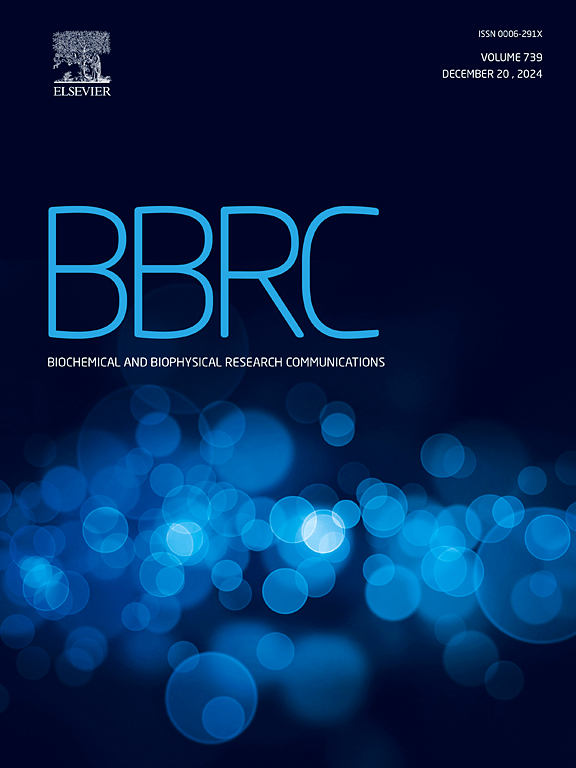RFFL inhibition increases cell surface CFTR and reduces IL-8 production in airway epithelial cells upon COPD-associated environmental pathogen exposure
IF 2.5
3区 生物学
Q3 BIOCHEMISTRY & MOLECULAR BIOLOGY
Biochemical and biophysical research communications
Pub Date : 2025-06-24
DOI:10.1016/j.bbrc.2025.152251
引用次数: 0
Abstract
Chronic exposure to environmental pathogens and pollutants can impair CFTR chloride channel function, contributing to chronic obstructive pulmonary disease (COPD). Our previous study demonstrated that pyocyanin (PYO), a COPD-associated pathogen factor, significantly reduces the functional expression of R75Q- or M470V-CFTR, two CFTR polymorphisms found in COPD patients, leading to increased IL-8 production in airway epithelial cells (AEC). In this study, we report that inhibition of RFFL, a ubiquitin ligase that targets CFTR mutants for removal from the plasma membrane (PM), mitigates excessive IL-8 production in AECs expressing R75Q- or M470V-CFTR, even in the presence of PYO. RFFL knockdown (KD) enhanced the functional PM expression of R75Q- or M470V-CFTR under PYO exposure, although it did not prevent PYO-induced CFTR downregulation. Our results indicate that RFFL likely regulates constitutive IL-8 production independently of CFTR, while also modulating pathogen-induced IL-8 expression through a CFTR-dependent mechanism. This highlights the potential of RFFL inhibitors to enhance CFTR function and reduce IL-8 secretion, even amid chronic exposure to environmental pathogens and pollutants, underscoring RFFL inhibition as a promising therapeutic approach for COPD management.
在copd相关的环境病原体暴露下,RFFL抑制增加细胞表面CFTR并降低气道上皮细胞IL-8的产生
长期暴露于环境病原体和污染物可损害CFTR氯通道功能,导致慢性阻塞性肺疾病(COPD)。我们之前的研究表明,pyocyanin (PYO)是COPD相关的病原体因子,可显著降低COPD患者中两种CFTR多态性R75Q-或M470V-CFTR的功能表达,导致气道上皮细胞(AEC)中IL-8的产生增加。在这项研究中,我们报道了抑制RFFL,一种靶向CFTR突变体从质膜(PM)去除的泛素连接酶,即使在PYO存在的情况下,也能减轻表达R75Q-或M470V-CFTR的aec中过量的IL-8产生。RFFL敲低(KD)增强了PYO暴露下R75Q-或M470V-CFTR的功能性PM表达,尽管它不能阻止PYO诱导的CFTR下调。我们的研究结果表明,RFFL可能独立于CFTR调节构成性IL-8的产生,同时也通过CFTR依赖的机制调节病原体诱导的IL-8表达。这突出了RFFL抑制剂增强CFTR功能和减少IL-8分泌的潜力,即使在慢性暴露于环境病原体和污染物的情况下,也强调了RFFL抑制作为一种有希望的COPD治疗方法。
本文章由计算机程序翻译,如有差异,请以英文原文为准。
求助全文
约1分钟内获得全文
求助全文
来源期刊
CiteScore
6.10
自引率
0.00%
发文量
1400
审稿时长
14 days
期刊介绍:
Biochemical and Biophysical Research Communications is the premier international journal devoted to the very rapid dissemination of timely and significant experimental results in diverse fields of biological research. The development of the "Breakthroughs and Views" section brings the minireview format to the journal, and issues often contain collections of special interest manuscripts. BBRC is published weekly (52 issues/year).Research Areas now include: Biochemistry; biophysics; cell biology; developmental biology; immunology
; molecular biology; neurobiology; plant biology and proteomics

 求助内容:
求助内容: 应助结果提醒方式:
应助结果提醒方式:


